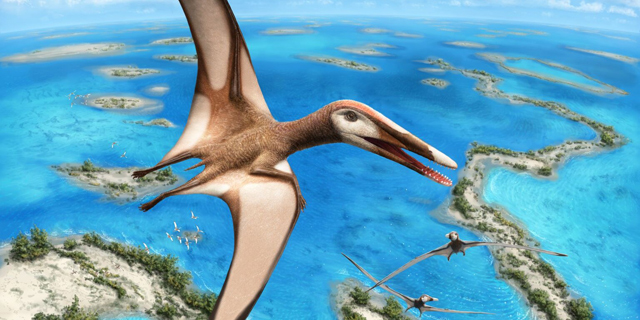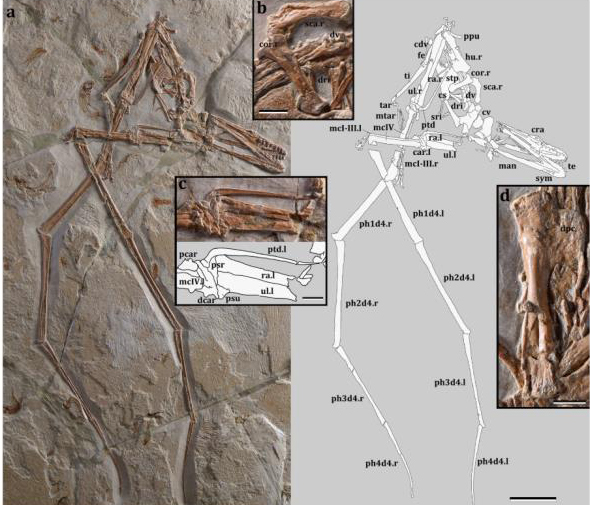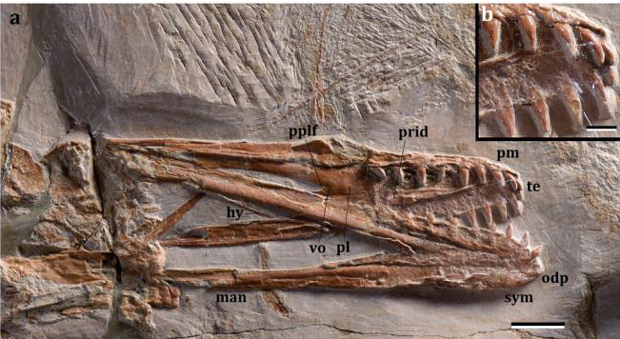Mimodactylus libanensis Newly Described Lebanese Pterosaur
The Pterosauria were very probably ubiquitous over much of our planet during the Mesozoic. Once these flying reptiles had begun to diversify during the Late Triassic and into the Jurassic, these winged-wonders, the first vertebrates to master powered flight, would have spread far and wide. Trouble is, although palaeontologists have described more than 120 genera, our knowledge of the Pterosauria is limited and scientists rely on a few key deposits to provide them with the majority of specimens to study. Pterosaurs are now known from every continent, but surprisingly, very little material has been collected from Africa and the Arabian peninsula.
Writing in the academic journal “Scientific Reports”, a team of international scientists have announced the discovery of a Late Cretaceous pterosaur from Lebanon. Mimodactylus libanensis is the most complete pterosaur specimen to have been discovered from the Afro-Arabian continent. Intriguingly, the fossil material shows a strong taxonomic affinity with a genus known from China (Haopterus gracilis), together the pair form a new clade of toothy pterosaurs – the Mimodactylidae.
A Life Reconstruction of the Newly Described Pterosaur Mimodactylus libanensis

Picture credit: Julius Csotonyi
Pterosaurs with Long, Narrow Wings
The fossil specimen comes from the famous Hjoûla Lagerstätte of Lebanon, a deposit famous for its beautifully preserved fossil fish, but tetrapod fossils are exceptionally rare. The nearly complete and articulated skeleton indicates that Mimodactylus had long, narrow wings and that it would have been well-adapted to soaring over the sea, in a similar way to extant frigate birds. As to what this pterosaur ate, that is open to speculation, but the robust, conical teeth located at the front of the jaws suggest a durophagus diet. Perhaps this pterosaur fed on molluscs and other shelled creatures.
A View of the Fossilised Remains of Mimodactylus libanensis

Picture credit: Kellner et al/Scientific Reports
The Mimodactylidae
The single specimen represents a sub-adult, the wingspan is estimated to be around 1.3 metres, but in the absence of any fossil material representing an adult animal, the actual size of a fully grown Mimodactylus is not known. A phylogenetic analysis of the 95 million-year-old specimen suggests that Mimodactylus libanensis is closely related to pterosaurs from Asia and that with the taxon Haopterus gracilis, which is known from the Yixian Formation of Liaoning Province (north-eastern China), it forms a new clade of derived toothy pterosaurs, the Mimodactylidae.
One of the co-authors of the scientific paper, Michael Caldwell (University of Alberta), commented:
“This means that this Lebanese pterodactyloid was part of a radiation of flying reptiles living in and around and across the ancient Tethys Seaway, from China to a great reef system in what is today Lebanon.”
What’s in a Name?
The genus name is from the acronym (MIM), the Mineral Museum of Beirut in Lebanon, where the specimen is housed and the Greek “dactylos” meaning digit. The trivial epithet honours Lebanon where this rare specimen was found. An honourable mention to the anonymous philanthropist who acquired the fossil and ensured this important pterosaur was kept in Lebanon.
A Closer View of the Skull and Jaws of Mimodactylus libanensis

Picture credit: Kellner et al/Scientific Reports
The scientific paper: “First complete pterosaur from the Afro-Arabian continent: insight into pterodactyloid diversity” by Alexander W. A. Kellner, Michael W. Caldwell, Borja Holgado, Fabio M. Dalla Vecchia, Roy Nohra, Juliana M. Sayão and Philip J. Currie published in Scientific Reports.
The Everything Dinosaur website: Everything Dinosaur.






Leave A Comment